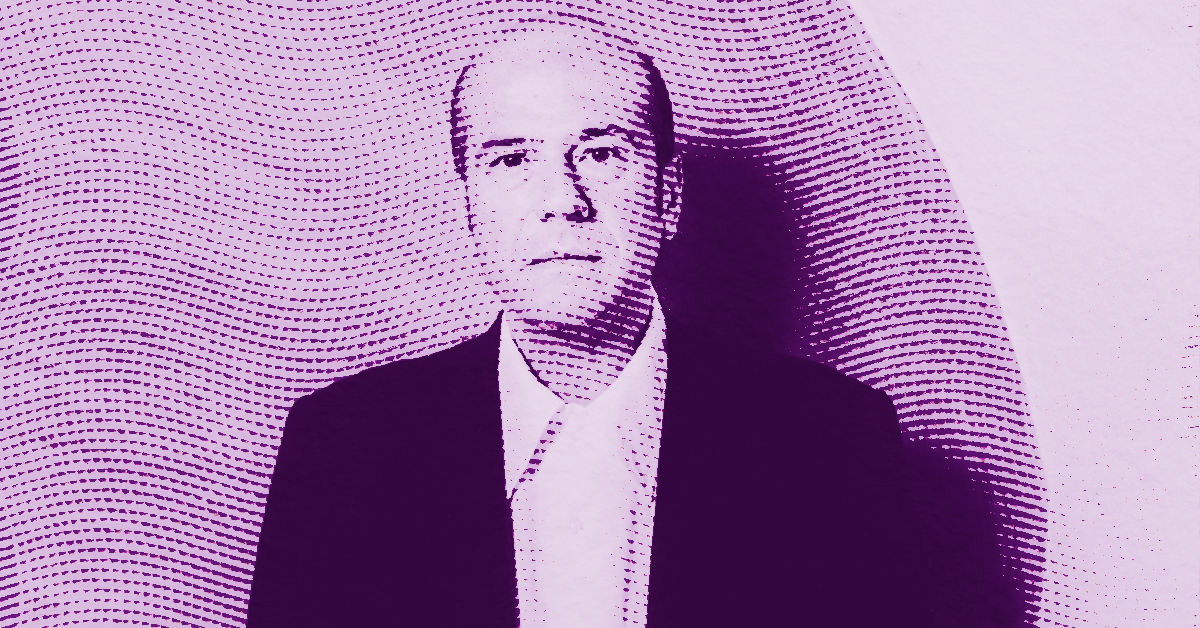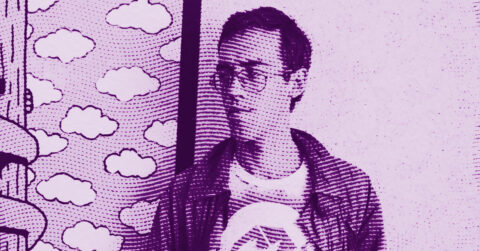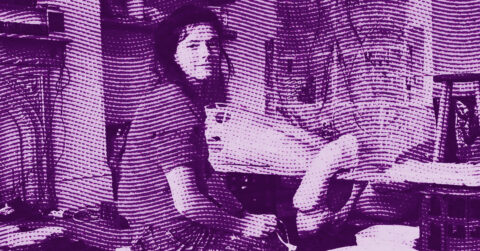Listen to me carefully, you bunch of snobs. There still exist in this sanitized world of contemporary art preserved territories where pure emotion resists mercantile calculations and conceptual poses. Nicola De Maria is a determined guardian of one such territory. For more than forty years, this man born in 1954 in Foglianise has been unfolding around the walls of the world a chromatic universe where poetry meets architecture, where painting overflows its frame to invade space and reinvent our relationship to place.
In this art market where trends succeed each other with the speed of an algorithm, De Maria maintains a disconcerting constancy. His series Regno dei Fiori [1], started in the 1980s, continues to bloom today with an obstinacy bordering on the sacred. These “kingdoms of flowers” are not mere painted gardens, but psychic territories where the artist unfolds a personal mythology made of primary colors, stylized stars, and symbolic houses.
De Maria’s journey begins with resistance. Trained in medicine with a specialization in psychiatry which he never practiced, he chose painting in 1977 in the conceptual Turin of the seventies, when everyone proclaimed the death of painting. First act of rebellion: creating his first mural painting in Milan the same year, then participating in the Paris Biennale. A prophetic gesture of a man who refuses boundaries between disciplines and media.
His recognition came in 1979 with his integration into the Transavanguardia movement theorized by Achille Bonito Oliva. Alongside Sandro Chia, Francesco Clemente, Enzo Cucchi and Mimmo Paladino, De Maria embodies a singular path: where his companions explore ironic or neo-expressionist figuration, he develops a lyrical abstraction drawing from the collective unconscious. This difference is not anecdotal. It reveals an artist who, from the beginning, refuses labels to forge his own path.
The collective unconscious
The work of Nicola De Maria reveals an intuitive understanding of the mechanisms of the collective unconscious theorized by Carl Gustav Jung [2]. This psychoanalytic dimension of his work goes beyond the mere decorative use of universal symbols to reach a true activation of Jung’s archetypes. Jung described the collective unconscious as “a foundation shared by humanity, containing archetypes: universal models” which manifest in mythological stories and artistic creations. In De Maria, this theory finds a pictorial application of rare coherence.
His stars are not simple ornamental motifs but manifestations of the archetype of the inner cosmos, this search for orientation in the psychic immensity that Jung identified as fundamental in the human being. The houses scattered across his canvases evoke the archetype of refuge, of the temenos sacred where individuation can be accomplished. As for the omnipresent flowers, they embody the archetype of perpetual rebirth, of the eternal cycle that governs both nature and the psyche.
This reading of Jung is enriched when observing the artist’s mural technique. His “Space Paintings” that invade the walls of galleries reproduce the individuation process described by Jung: the viewer, immersed in these colorful environments, experiences a transformation where the boundaries between the self and the space temporarily dissolve. This dissolution is not pathological but therapeutic, allowing the personal unconscious to dialogue with the collective unconscious.
De Maria’s use of primary colors also fits into this archetypal logic. Red evokes vital energy, the libido in Jung’s sense. Blue calls upon spiritual infinity, transcendence. Yellow radiates solar consciousness, the clarity of awakening. These colors, applied in thick layers according to the ancient fresco technique, do not seek chromatic sophistication but a primal impact on the psyche.
Jung observed that “archetypes sometimes appear in their most primitive and naive forms (in dreams), sometimes also in a much more complex form due to conscious elaboration (in myths).” De Maria’s art constantly navigates between these two poles. His drawings on paper retain the spontaneity of the dream, while his mural installations reach the complexity of the elaborated myth.
This psychoanalytic dimension explains why De Maria’s works produce such a particular effect on the viewer. They address not only the eye but this “memory of the species” that Jung located in the collective unconscious. Facing a Regno dei Fiori, we do not contemplate a simple decorative abstraction but a contemporary mandala that activates our deepest psychic structures. De Maria himself expresses this aptly when he describes himself as “the one who writes poems with his hands dipped in colors” [3]. This formula reveals the artist’s awareness of drawing from a universal language that goes beyond simple pictorial technique.
The installation Angeli proteggono il mio lavoro (1986), created for his first American exhibition, perfectly illustrates this approach. By painting directly on the walls and ceiling of the exhibition space, De Maria transforms the architecture into a colored maternal womb where the spectator experiences a positive regression towards the archetypes of protection and rebirth. This work does not just decorate the space: it re-sacralizes it by activating our collective memory of the protected place.
Architecture as a spiritual territory
The second fundamental dimension of De Maria’s work lies in his revolutionary relationship to architecture and spatiality. This approach finds its roots in the Italian tradition of mural art but reinvents it according to a contemporary logic that echoes the architectural research of the Italian Renaissance. Just as Brunelleschi revolutionized 15th-century construction art by subjecting architecture “to a rule determining the proportional relationships between the different parts of the building,” De Maria develops a pictorial system that entirely rethinks the relationship between the work and its spatial environment.
De Maria’s innovation consists in treating architecture not as a mere support but as a creative partner. His murals do not merely occupy wall surfaces: they transform their very nature. When he paints the walls and ceilings of a gallery, he does not decorate the space but symbolically re-founds it. This approach recalls Brunelleschi’s revolution who, according to art historians, “particularly cultivates the rigor and sobriety of plans” to “create a very harmonious optical effect.”
The fresco technique claimed by De Maria establishes a direct link with the masters of the Italian Renaissance, but according to an inverted logic. While Renaissance fresco painters sought to create the illusion of depth on a flat surface, De Maria uses pure color to abolish the traditional perception of architectural space. His colored walls no longer recede towards a vanishing point but radiate towards the viewer, creating an effect of spatial expansion that transforms architecture into an inner cosmos.
This spatial revolution finds its most accomplished expression in his public installations, notably Regno dei fiori: nido cosmico di tutte le anime (2004), created for the Luci d’Artista in Turin. By transforming the lampposts of San Carlo square into luminous flowers, De Maria performs an architectural gesture of rare boldness: he reinvents urban lighting as a poetic system that metamorphoses the perception of public space. This intervention does not just beautify the square: it reveals its hidden spiritual dimension.
De Maria’s spatial approach aligns with the research of contemporary Italian architects who, according to analysts, “marry tradition and innovation” by developing “a bold use of contemporary materials.” But whereas contemporary architecture uses glass and steel, De Maria employs pure color as an architectural material. His natural pigments applied according to the traditional fresco technique create surfaces that literally transform the luminous and acoustic properties of the space.
This architectural dimension explains why De Maria often prefers exhibiting in historic places rather than in neutral white cubes. He needs dialogue with pre-existing architecture to reveal his own spatial vision. His interventions in palaces, churches, or converted industrial spaces create fertile tensions between old and contemporary, sacred and profane.
Color becomes for him a true architectural language. Each shade has its specific spatial function: reds expand the space and create a sensation of warm intimacy, blues elevate it towards the spiritual infinite, yellows illuminate it with an inner light. This functional use of color recalls modern architecture’s research on the psychological effect of materials but applies it according to a purely pictorial logic.
The installation becomes in De Maria a total art encompassing painting, architecture, and poetry. His titles, often long and poetic, do not describe the work but constitute a verbal extension of it. “La testa allegra di un angelo bello” or “Universo senza bombe” function as mantras that guide the spatial perception of the viewer. These words painted or written on the walls create a literary dimension of space that recalls the sacred inscriptions of religious architectures.
This global approach to space reveals in De Maria a conception of art as a transformation of lived experience. His works do not simply need to be looked at: they physically and psychologically modify the experience we have of the place. In this sense, De Maria fulfills the dream of modern architecture to create spaces that transform their inhabitants, but by purely artistic means.
The resistance of the sensible
In an art market obsessed with novelty and transgression, De Maria opposes the consistency of a research that constantly deepens the same fundamental questions. His “Teste Orfiche” presented at the 1990 Venice Biennale [4], monumental canvases over five meters wide, reveal an artistic maturity that fully embraces its obsessions. These works seek neither provocation nor fashion effects but tirelessly explore the question of pure emotion in painting.
American criticism has sometimes reproached De Maria for his refusal of postmodern irony and critical deconstruction. This misunderstanding instead reveals the singularity of his position: in an art world dominated by distrust of emotion, he maintains an unwavering faith in the transformative power of art. His works from the 2000s and 2010s confirm this orientation with explicit titles like “Universo senza bombe” or “Salvezza possibile con l’arte”.
This position is far from naïve. It stems from a particular lucidity about contemporary art issues. De Maria understands that true subversion today consists in rehabilitating aesthetic values that ambient cynicism has disqualified. His use of primary colors and simple forms is not a regressive primitivism but a sophisticated strategy of cultural resistance.
The recent evolution of his work confirms this orientation. His works on paper multiply poetic notations and references to music, creating visual scores where each color corresponds to a note, each form to a rhythm. This assumed synesthesia places De Maria in the lineage of great colorists who, from Kandinsky to Rothko, sought to make painting a total art.
His recent installations also develop an ecological dimension that enriches his message without betraying it. Regno dei fiori musicali. Universo senza bombe (2023) integrates sound elements that transform the exhibition space into a complete sensory environment. This evolution toward total art respects the deep logic of an artist who has always refused boundaries between disciplines.
The longevity of De Maria’s career, his exhibitions in the greatest international institutions, his regular presence in public collections testify to a recognition that goes beyond fashion phenomena. His art spans generations because it addresses constant anthropological needs: the need for beauty, spirituality, connection with vital forces.
This permanence in a volatile art world reveals the prophetic relevance of De Maria. Forty years ago, his choice of painting within conceptual Turin seemed anachronistic. Today, as new generations rediscover the need for spirituality and connection to nature, his work appears visionary. His “kingdoms of flowers” offer psychic refuges in an increasingly dehumanized world.
Art as secular prayer
The work of Nicola De Maria accomplishes the feat of rehabilitating the spiritual dimension of art without falling into cheap mysticism. His installations create spaces of secular contemplation where aesthetic contemplation meets meditative experience. This spiritual dimension proceeds from no religious dogma but from a fundamental trust in the healing power of beauty.
When De Maria paints “Regno dei Fiori,” he does not represent flowers but creates the conditions for a psychic blossoming within the viewer. His pure colors act as visual mantras that soothe mental agitation and reconnect with natural rhythms. This therapeutic function of art aligns with contemporary research on art therapy but accomplishes it through purely aesthetic means.
The obsessive repetition of the same motifs, stars, houses, and flowers, creates a hypnotic effect that facilitates access to altered states of consciousness. This repetition is not monotony but creative rumination that progressively deepens understanding. Each new “Regno dei Fiori” reveals new facets of this poetic universe that seems inexhaustible.
The inscription of words and poetic phrases in his paintings adds a literary dimension that enriches the aesthetic experience. These texts do not describe the image but create a verbal counterpoint that guides meditation. When De Maria writes “La montagna mi ha nascosto la luna, cosa devo fare?” (The mountain has hidden the moon from me, what should I do?), he is not posing an anecdotal question but expressing humanity’s fundamental existential anxiety in the face of cosmic immensity.
This spiritual dimension explains the attraction that De Maria’s work exerts on very diverse audiences. His installations draw as much the contemporary art lovers as spiritual seekers, children as well as elderly people. This cross-cutting appeal reveals the accuracy of his intuition: true art addresses what is universal in every human being.
De Maria’s art offers a concrete alternative to contemporary nihilism. Faced with a disenchanted world, he keeps alive the possibility of an experience of the sacred through beauty. His “universes without bombs” are not naive utopias but experimental laboratories for calm ways of being. In his installations, for a few moments, the world’s violence is suspended and replaced by a fragile but real harmony.
This work reminds us that art still possesses, despite its commodification, a power of spiritual transformation that resists all co-optation. By keeping alive this sacred dimension of art, Nicola De Maria accomplishes a cultural act of resistance of considerable scope. He proves to us that it is still possible, in the 21st century, to create works that elevate the soul without renouncing intelligence.
The eternal present of creation
An obvious fact imposes itself: we are facing a major artist whose work will gain even more recognition in the decades to come. His ability to keep alive a millenary pictorial tradition while adapting it to contemporary challenges reveals a rare artistic mastery. His rejection of conceptual shortcuts and gratuitous provocations testifies to an ethical demand that honors contemporary art.
Nicola De Maria’s work teaches us that true avant-garde sometimes consists in preserving what modernity threatens to destroy. By keeping alive the link between art and spirituality, between painting and architecture, between the individual and the collective, he accomplishes an essential cultural safeguarding work. His “kingdoms of flowers” constitute refuges where aesthetic and spiritual values that our era has too quickly abandoned are preserved.
This work also invites us to rethink our criteria for evaluating contemporary art. Formal novelty, critical transgression, ironic deconstruction are not the only criteria of artistic quality. The patient deepening of a research, fidelity to a poetic vision, the capacity to move and elevate hold equal or perhaps greater legitimacy.
Nicola De Maria proves to us that it remains possible, even in the disenchanted context of postmodernity, to create art that reconciles man with his highest aspirations. His installations offer us moments of grace that compensate for the brutality of everyday life and nurture this “hunger for beauty” secretly felt by most of our contemporaries.
In front of his works, we understand that true art does not merely represent the world: it transforms it by revealing its hidden potentialities. De Maria’s “universes without bombs” are not escapisms but prefigurations of a possible world where beauty would triumph over violence. In this sense, this art fulfills its highest prophetic function: it maintains hope for a better future and gives us the spiritual means to build it.
Nicola De Maria’s work reminds us that art remains, despite all historical vicissitudes, a privileged path to the sacred. In a world that has lost its traditional spiritual landmarks, his installations offer spaces for reflection where everyone can reconnect with that transcendent dimension that constitutes the essence of humanity. This anthropological function of art, which the 20th century avant-gardes believed had been definitively abolished, finds in De Maria a troubling actuality that questions our own spiritual needs.
Thus, far beyond the aesthetic quarrels of his time, Nicola De Maria accomplished the feat of reconciling contemporary art with its eternal vocation: revealing the hidden beauty of the world and offering men reasons to hope. This work, which already spans five decades, will accompany us for a long time in our common quest for an art that is at once contemporary and timeless, sophisticated and accessible, local and universal.
- Galerie Lelong & Co., “Nicola De Maria – Regno dei Fiori”, exhibition catalogue, Paris, 1988
- Carl Gustav Jung, Man and His Symbols, Robert Laffont, Paris, 1964
- ABC-Arte, interview with Nicola De Maria, Turin, 2018
- Laura Cherubini, Flaminio Gualdoni, Lea Vergine (eds.), Biennale di Venezia – Padiglione Italia, official catalogue, Venice, 1990
















